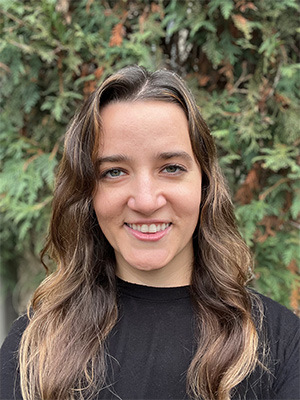Editorial design and production directors wear many hats. From investigating market trends to reviewing printer proofs to discussing design with typesetters and cover designers, just about anything you can think of within book design and production falls in the purview of these professionals.
For Ana Bichanich, serving in this position at the University of South Carolina Press gives her an opportunity to help reshape the role of scholarly presses. And, after ten years working as a production editor at the University of Minnesota Press and two years as part of the charge on a new initiative there, she’s eager to share her particular passion with the Carolina community: her work on accessibility.
“The publishing industry has been very focused on a single kind of reader—someone who reads with their eyes,” says Bichanich. “That doesn’t encompass all of us, so accessibility is making sure that the information we want to publish can be read by anyone who wants to access it and that we aren’t building barriers into the structure of the books.”

At Minnesota, Bichanich was a key instigator in pushing for more accessible publications, starting with her work on e-books. She was responsible for creating and coding e-books, which raised lots of questions about including broader audiences. How will the descriptive text for graphs and tables interact with assistive technology? Will a screen reader pronounce these words in the correct language? Can the font size or text alignment be changed to help low-vision readers and readers with dyslexia better process the words on the page?
Accessibility, at its core, is about ensuring that everyone is included. “It’s not that we have to make these publications accessible for certain groups of people,” says Bichanich. “Accessibility is as broad as you can make it.”
Take, for example, text-to-speech features. Using the accessibility features coded into e-books to accommodate text-to-speech readers, just about any book can become an audiobook—convenient for a student biking to class or a working professional driving to a meeting, and necessary for a person whose sight is impaired. The clear navigation and headings required for accessible books are another asset that provide text organization cues to all readers.
After a decade at Minnesota and ready for a career change, Bichanich was eager to take her talents to USC Press. She was attracted to the university’s increased commitment to inclusivity initiatives in recent years, and the scope of her work is a valuable asset to advancing those initiatives on campus.
“The University of South Carolina is committed to making it accessible for all students, faculty and staff to participate inside and outside of class,” says Julian Williams, vice president of division of access, civil rights and community engagement. “Innovative technology is one way we can deliver equal access to print for everyone, and removing common barriers will allow us to progress toward providing a fully inclusive and equal education.”
Bichanich was especially excited by the Press’ recent launch of Open Carolina, an open access platform that allows users to read scholarly articles and books without cost, and she was confident that her own vision for accessibility would be met with excitement.
“Increasing access to our books takes many forms,” says Michael McGandy, director of USC Press. “We want to lower and then remove barriers for the authors, creators, readers and consumers of our books. Sometimes that is done by reaching out and inviting in folks who have been kept on the outside of the content we publish. Other times it is done by innovating with digital technologies to enhance access. Ana is doing both and I think that is just fantastic.”
Moving forward, Bichanich will play a key role in shaping a formal USC Press initiative to increase accessibility in press publications. It’s exactly what she has had in mind from the early days of her work in improving access in the publishing industry.
“Setting up barriers to learning, education and the sharing of ideas is counter to what we want to accomplish,” says Bichanich. “We can’t expect people to be a certain way, to be able to do certain things or to have preferences that align with the way things have always been. Access encompasses anything and everything that allows people to be their full selves while we do this work together.”